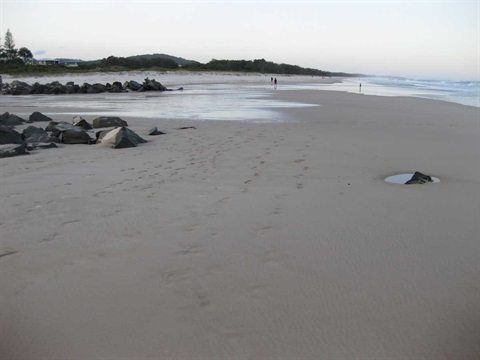Council continues to monitor conditions in Pottsville’s Mooball Creek
12 October 2018

Water quality tests show water is still safe for swimming and health of aquatic life
The Mooball Creek mouth at Pottsville is completely closed by sand and Council is continuing to monitor water quality and sand movement very closely.
With the vast amount of sand on our beaches at the moment, the beach has grown wider than the entrance walls and the whole lower estuary is full of sand.
The water quality in the creek is being monitored daily at multiple sites for dissolved oxygen, salinity and pH, and near the bridge, three times per week for bacteria and algae. These tests have shown water in the lower estuary is consistently meeting water quality objectives for the protection of aquatic ecosystems and swimmer health.
Acting Director Community and Natural Resources, Jane Lofthouse, said the latest bacteria monitoring result is from Tuesday and is well within guidelines for safe swimming.
“The creek is greener than usual, which is due to the growth of free floating single cell algae (phyto-plankton). The algae has also been assessed and is not a health risk. Dissolved oxygen and pH levels are well within guidelines for protection of aquatic ecosystems,” Ms Lofthouse said.
Council is progressing relevant State Government permits to open the creek mouth so work can be undertaken if water quality monitoring confirms there is a problem, or suggests there are likely to be problems.
“We are focused on ensuring any removal of the bar is effective in restoring tidal flushing, not just draining the creek,” Ms Lofthouse said.
Community members considering digging a channel to attempt to open up the creek are advised that NSW Department of Primary Industries Fisheries supports minimal interference with creek mouth sand barriers and advocates natural processes being allowed to operate to the greatest extent possible.
“If not done properly and under the right conditions, there is a real possibility opening up the creek with machinery or by hand digging could make the problem worse,” she said.
“This is because good quality water drained out of the lower estuary would be replaced by lower quality water presently sitting in the upper estuary and cane drains of Wooyung. This water is lower in dissolved oxygen and has a lower pH, and potentially higher bacteria levels,” she said.
The maximum penalty for unauthorised works to open a closed estuary is $220,000 for Councils and $110,000 for individuals.
Water levels within the creek have now risen and continue to rise slightly due to overnight rain.
The need to put machinery onto the beach to undertake an artificial opening will be reassessed on Monday 15 October.
Downloads
Photo 1(JPG, 62KB)
Caption: With the vast amount of sand on our beaches at the moment, the beach has grown wider than the entrance walls and the whole lower estuary is full of sand.